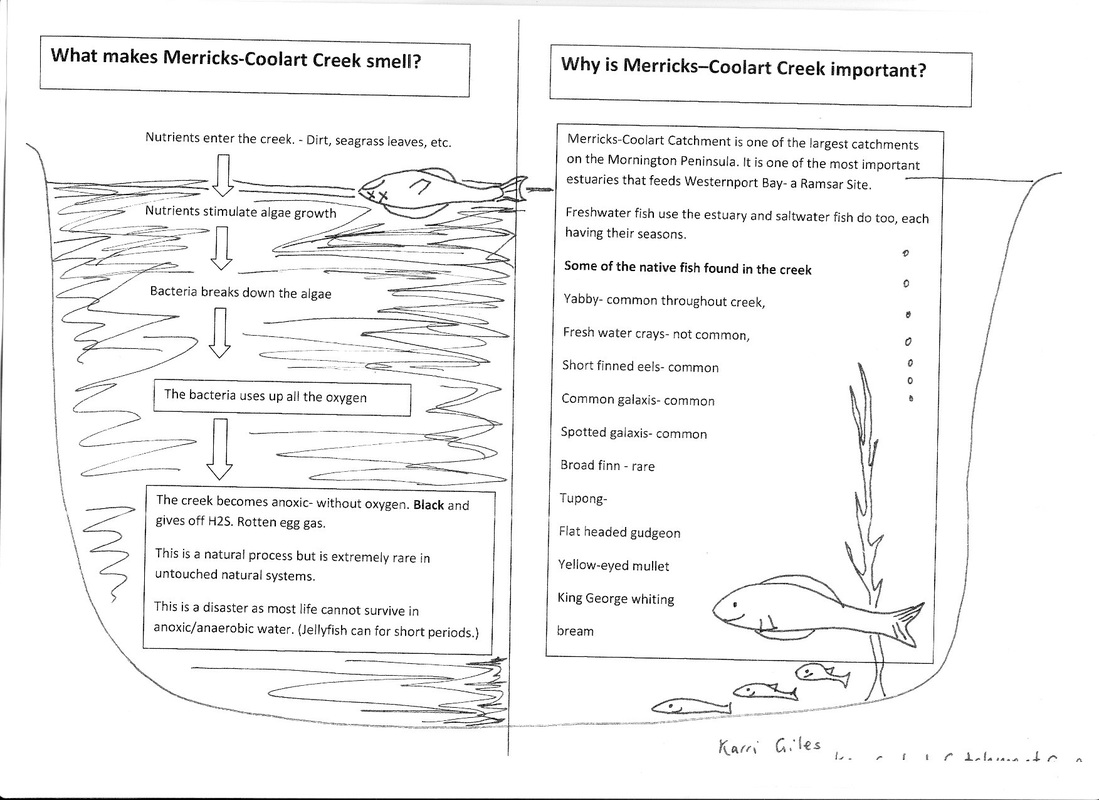Merricks Coolart Creek
|
.Karri Giles was nominated as Merricks Coolart Catchment Group's representative on the Melbourne Water Working group. She has done water testing in the creek for years.
The submission I emailed to the email list of the working group before the first meeting has some suggestions to improve and protect the creek.This is below. MW working group meeting February 2016 The Dissolved oxygen has been steadily declining since the creek was blocked off at the mouth on a full tide 12th November and salinity has been rising.Thanks Geoff Hall for your testing. Southern Rural Water was asked to see if there was any possibility of compensation flows and Frank Crammeri said that he would look into it. This may yield some flows but we really need rain.Though light rain to get the grass growing first before heavy would be good because of the cows trampling in the rural catchment. MW is initiating a program that has been successful called mitigating catchment inputs to rural landholders to fence of creeks, look at improving run-off and look at modifying thier dams and diversions for the benefit of the creek. Geoff Hall suggested that the creek is temporarily pumped with seawater and then breached to allow the sand to scour out. This would replicate a natural process and the community reps seemed in favour of this so MW is looking into it. The Mornington Peninsula Biosphere has agreed to make this creek a priority and after it's fantastic work in Watsons Creek we are very pleased. The estuary has not been producing the same level of H2S as it did last Summer perhaps due to the lack of hot weather which has allowed oxygen to remain in the water, though the water is stratified so that some is anoxic and lets off H2S. The seagrass does not seem to produce enough nitrogen or Phosphorous to trigger eutrophication to the degree that causes anoxia. This warm season instead of the creek going black the seagrass has been breaking down and forming a white precipitate that gives the creek a chocolate milk colour. I have been photograghically monitoring the creek this spring and early summer as it when through many changes of colour, and became very concerned about the white colour thinking it was clay. I encouraged The Shire and The EPA and MW to take action and Emily from the environmental health section of The Shire did. She took water samples and sent them to a lab and rang me. She has not got back to me with formal results however it seems that the white colour which is diluted now, making the creek milk coffee coloured, rather than its usual black anoxic summer colour, may be due to the white precipitate as a result of the break down of the seagrass leaves. At the November MW working group meeting I was told the white precipitate which was sitting onto of the dark brown seagrass leaves under sulphur yellow water was hydrogen sulfate. I looked hydrogen sulfate up and it said that it was black and highly soluble so It probably isn't. |
LocationBalnarring Estuary
|
|
Your browser does not support viewing this document. Click here to download the document.
This is the submission from Merricks-Coolart Catchment Group to the MW working group. |
|
|
Your browser does not support viewing this document. Click here to download the document.
|
